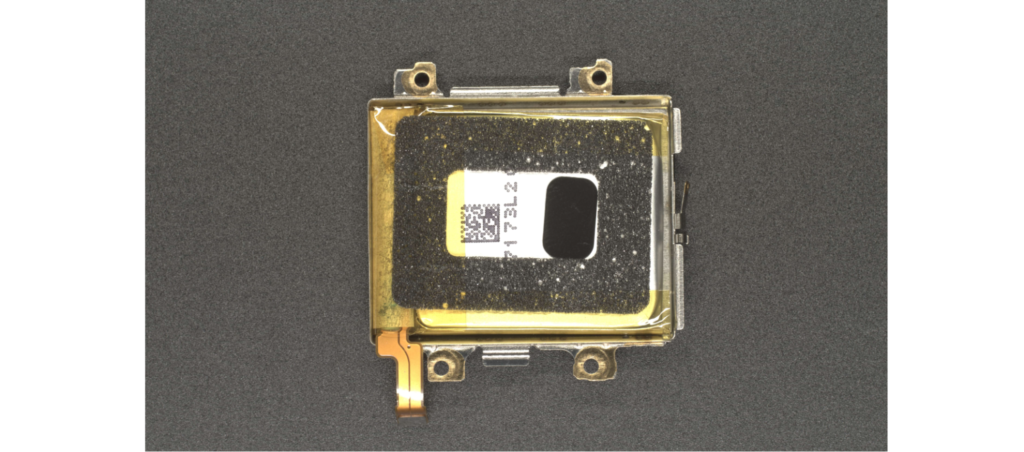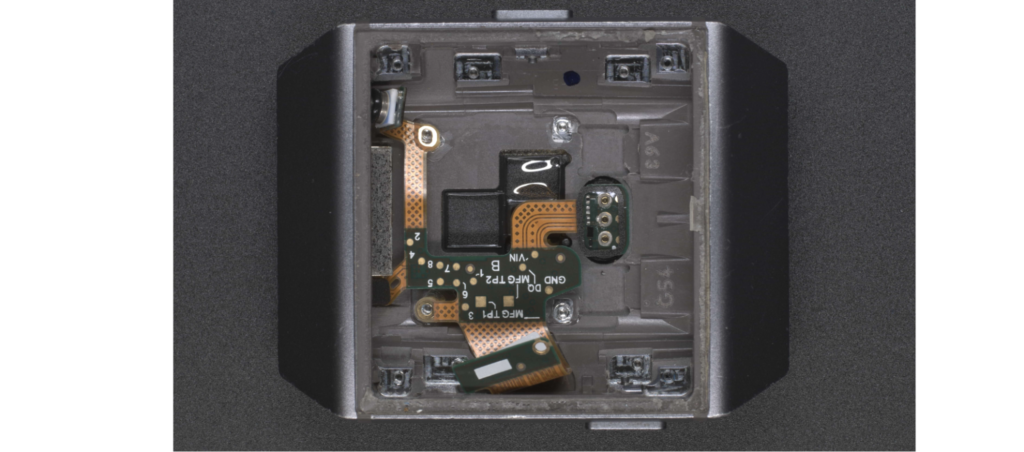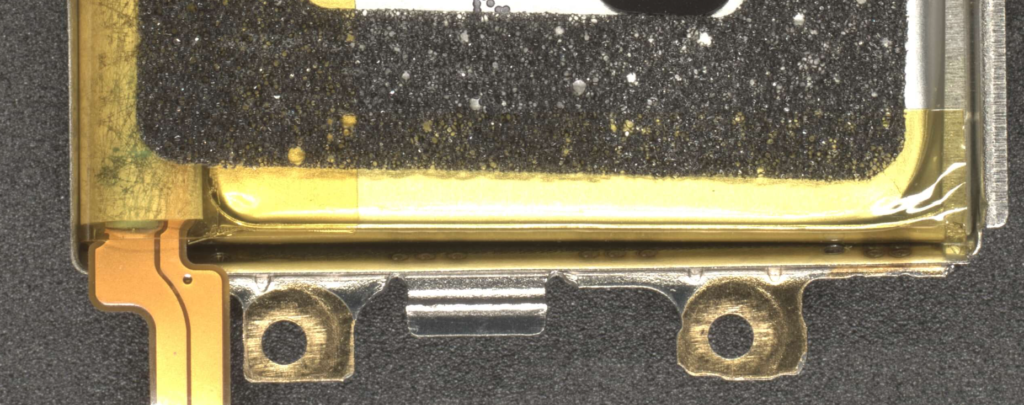In March, Fitbit announced it was making the tough decision to recall one of their smartwatches — the Fitbit Ionic — following reports of overheating battery events that caused burns on users’ wrists.
As engineers and designers, we know that product recalls are always rough. After countless hours of engineering, manufacturing, and happy customer use, it can be disheartening to see a product put customers at risk and get taken off the market. However, we know that there are lessons in the recalls. We wanted to teardown the Fitbit Ionic to learn about the battery — so when our audience also requested a teardown of a smartwatch, we knew just what to do.

Front view of the Fitbit Ionic Smartwatch
While we don’t have any insider knowledge of how this product was made or why it failed, we were interested in uncovering insights of what could have caused the battery to rapidly overheat. Here’s what we found.
A deep dive into the Fitbit Ionic battery
First released in 2017, the Fitbit Ionic was in production for a little over two years before being put aside for newer models. With its angular shape and aggressive styling, the watch has a striking design with its antenna cleverly integrated into the main housing. It also came packed with a lot of technology for the time, including a heart rate monitor, NFC antenna, barometer, haptic response and more. Since we purchased these devices second hand without any bands, we can see how they have held up over the last few years and I have to say aside from a few scratches on the cover lens, they look great.
After describing the major features and design during our live teardown, I joined my fellow teammates, Tobias and Molly, to quickly walk through the disassembly of the display, NFC antenna, and main logic board so we could get to the meat of the discussion surrounding the battery.

Fitbit Ionic with the display, NFC antenna, and PCBA removed showing the battery
The Fitbit Ionic features a lithium-ion battery like many of today’s consumer electronics. Lithium-ion batteries are ubiquitous because of their high energy density. From early on in their development until today, lithium batteries have been the source of several major product recalls. Laptops with Sony batteries in 2006, the Samsung Galaxy Note 7 in 2016, and the Chevy Bolt in 2021 are just a few of the many products that seemed to be at risk for spontaneous combustion — and all housed lithium-ion batteries.
This incendiary phenomenon, also known as thermal runaway, occurs when a defect or other adverse event shorts together normally separate oppositely charged elements of a battery, causing the battery temperature to rise rapidly. The rapid temperature rise itself induces faster chemical chain reactions which increases the temperature even further until the chemicals are used up or the heat causes something else in the system to fail and catch fire.
Let’s see what we can learn from the design of the Fitbit Ionic smartwatch and look for potential causes of thermal runaway in the mechanical design.
Potential Root Cause #1: Long-term stress concentration points and dendrite growth
The anode and cathode within a Li-ion battery can start to degrade through temperature, time, and usage, reducing overall capacity. A standard specification in industry is that batteries are designed to retain 80% of charge after 500-1000 cycles. When a battery degrades, elements of the anode and cathode are undergoing chemical changes. One of the more dangerous changes is lithium dendrite formation which are small structures that build on one another to a point where they can pierce the separator between the anode and cathode shorting them. A long-term stress concentration might squish layers of the battery closer together and become a trigger for this failure mode.
Bracket design
One of the first things that caught our attention was the hole in the otherwise smooth metal bracket. This is an odd design choice and something none of us had ever seen before. In a sheet metal punch, like in the hole below, a burr will form on the opposite side of the die. We checked to see which side the burr was on and found it to be on the side facing away from the battery. Still, we couldn’t help but worry that the hole, if not properly protected against, could be a stress concentration in the wrong circumstances.

Battery enclosure removed from the housing. Note the large hole over the battery and plated flanges
In the image above, we see the designers tried to fill the hole with a soft non-conductive foam but the foam is not centered. If the foam was designed to protect the battery from the sharp edges, it should be larger. If instead it was intended to serve as a spacer to the PCB above, then it should be smaller. As it stands, this foam appears to sit partly under one side of the sheet metal and could become a stress concentration because the battery is taped to the underside of the bracket sandwiching the foam.
In our teardown discussion, we came to the conclusion that the cutouts in the sheet metal were likely added to maximize antenna performance. Improving antenna efficiency can increase battery life while reducing harmful radiation. For a tiny product designed to be worn for several days at a time, every little bit of extra battery life counts so it would have been a difficult decision to balance the risk to the battery against the performance boost.
Plastic spacer and exposed components
Another area of interest in this Fitbit Ionic smartwatch is under the battery. A thin black plastic spacer sits within the foam on the battery. This corresponds to a similarly shaped flex where the charger pins are assembled to the main housing.

Underside of the battery assembly. Note the black plastic spacer near the center of the battery.
A magnetic charging cable constantly applies pressure upward on this component when the device charges, so it’s no surprise that the engineers at Fitbit wanted to distribute the load across a wider surface area. That said, the spacer itself appears to be skewed and may not line up with the charging pins. This is another uneven distribution of the force and could introduce a bigger stress than designed.
Potential Root Cause #2: Sudden impact at a sharp edge or point
Another potential failure mode for a lithium battery is a sudden impact at a sharp point. While not as obviously dangerous as a puncture from a nail or screw, consumer devices are often subjected to drops or other sudden changes in acceleration where components that are not meant to touch come into sudden contact. To combat this, mechanical designs around a battery often try to incorporate physical gaps around the perimeter and in the z dimension and minimize any sharp elements nearby.
Lithium-ion batteries will swell uniformly in thickness about 10 percent over their usable lifetime due to some degradation of the components. This means that any designed gaps need to account for that growth. The engineering team at Fitbit added a thin foam to help account for the Z gap as shown above, but there are a number of exposed components, screws, and sheet metal directly beneath it. If the battery were to swell more than the average 10%, the battery could get much closer to the components and the foam would have less room to compress.

Sensor board and magnets underneath the battery
Another risk in this scenario is if the adhesive used to fix the battery loosens over time. In the Fitbit Ionic, the designers used a ring of pressure sensitive adhesive around the perimeter of the battery instead of a solid sheet. In our teardown of the product, we were worried that it would be difficult getting the battery out of the bracket, but that proved to be surprisingly easy. If pressure wasn’t applied evenly or for enough time at installation, the adhesive may not have been activated properly and could fail over time.
From the image below, we can see that though there was a designed in uniform gap around the perimeter, this specimen shows the battery shifted toward the bottom and left of the bracket. (This could also explain the shifted foam in the hole above). While the 3D CAD was likely designed with the battery perfectly centered in the bracket, translating that design intent into acceptable tolerance on the line is often a balancing act between speed of assembly, cost of labor, and the cost of fixturing and training.

Closeup of the battery. Note the laser welds at the bottom and the uneven gaps around the perimeter
If the adhesive starts to fail during the product’s lifetime, it would not take much for the battery to loosen in this smartwatch. Since it is meant to be worn 24/7, the band likely gets exposed to harsh environments, constant movement, and sudden impacts like a drop or smack into a wall. In this case, a loose battery could suddenly shift and bounce against the side of the small laser welds for the grounding tabs in the X and Y directions or hit some of the sharp components below.
Potential Root Cause #3: Water ingress in the battery region
While early Fitbit fitness trackers were designed to be sweatproof, the Ionic was one of their first products to be rated as water resistant to 50 meters. In fact, they actually created features to help track swimming laps even though they never officially claim it to be waterproof.
It is conceivable that a casual user who swims or showers with the product could subject the device to more hours underwater than it was designed for. If enough moisture seeped into the system, it would only be a matter of time before the terminals of the battery shorted.

Potential water ingress points at the coverlens and the heart rate sensor lens
In our teardown, we found that Fitbit engineers had done a lot to prevent water from entering the system. The major ingress points in the watch are the coverlens, the heart-rate sensor lens, and the openings for the three buttons and the barometer but each of these areas was designed to be tightly sealed.
We were initially concerned that the insert-molded metal frame might allow water to wick between the bond of the aluminum housing and the plastic, but upon further inspection, we see that the interior of the smartwatch is actually mostly plastic. This construction isolates the sensitive electronics from even the hint of moisture from this pathway.

Double O-ring seal at the button plunger
In addition, the barometer and side buttons were sealed with small rubber o-rings to prevent water from entering through these small holes in the housing. In fact, this design shows two O-rings back to back which should provide a redundant seal.
While the initial product was almost certainly tested to meet the claimed water resistance in a pressure chamber or water test on the line, it is conceivable that through heavy usage or incidental damage the seals around these ingress points could wear and moisture could enter into the system.
Inherent design risks of product engineering
So, what went wrong with the Fitbit Ionic smartwatch? It’s hard to definitively say. It could have been none or a combination of the issues we highlighted. But the fact that this recall came after the product was in the field for over four years shows that much of the design was vetted through plenty of serious engineering work.
From the CPSC report, of the 1.7 million devices sold, only about 170 devices were reported to have an overheating battery failure. This represents about 0.01% of the total population, a number which could have easily slipped through several development builds or even worse, been characterized as a one-off failure. This recall is a sobering reminder that risks exist at every step along the product journey from design to manufacturing to real-world usage and that we always need to consider the tradeoffs between performance, cost, design, and most importantly, safety.
Chris Li is a former Amazon Product Design Engineering Manager and teardown lead for Instrumental. He brought multiple generations of the Kindle to market and advised on the first Echo and Fire TV products. He also worked as the VP of Product Design at the healthtech startup, PillDrill, which shipped an award winning medication tracking system. Recently, he joined Agtonomy, an autonomous tractor startup, as a Mechanical Engineer.
>>>
Is there another recalled product you’d like us to teardown? Do you know what went wrong with the Fitbit Ionic? Let us know, or join us for our next teardown which will be live at our headquarters in Palo Alto, CA on June 16th! If you want access to the full teardown library, reach out at communications@instrumental.com.
Related Topics



